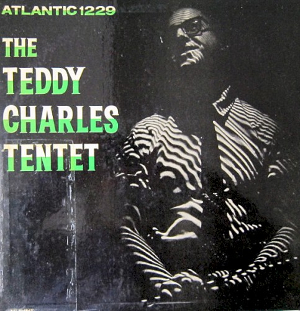The Teddy Charles Tentet
| The Teddy Charles Tentet | ||||
|---|---|---|---|---|
 |
||||
| Studio album by Teddy Charles | ||||
| Released | 1956 | |||
| Recorded | January 6, 1956 | |||
| Genre | Jazz | |||
| Length | 67:24 | |||
| Label | Atlantic Records | |||
| Producer | Nesuhi Ertegun | |||
| Teddy Charles chronology | ||||
|
||||
| Professional ratings | |
|---|---|
| Review scores | |
| Source | Rating |
| Allmusic | |
| Billboard | Positive |
The Teddy Charles Tentet is a 1956 jazz album featuring a tentet led by multi-instrumentalist Teddy Charles. Critically well received, the album is listed as one of the "Core Collection" albums in The Penguin Guide to Jazz and an essential recording in 2000's The Essential Jazz Records: Modernism to Postmodernism. Released originally in high fidelity vinyl by Atlantic, the album has been reissued on CD and LP multiple times since 2001.
The original album included music recorded at three different sessions. The first, on January 6, 1956, in New York City produced "Quiet Time" and "Nature Boy". The tentet reassembled five days later to record "Green Blues" and "You Go To My Head." On January 17, Sol Schlinger filled in on baritone saxophone for George Barrow to help record "Vibrations", "The Emperor", and "Lydian M-1". The additional tracks standard on CD releases of the album were recorded in New York on October 23, 1956, with a substantially different line up.
The album has been critically well received. Writing at the time of release, Billboard declared the "provocative, far-out material" a "must" for modernists, a "real tour-de-force" of "advanced, experimental" jazz chamber music. Contemporary reviewer Scott Yanow, writing for AllMusic described the arrangements of the music as advanced, but noted that they "often leave room for some swinging spots." Speaking of CD re-releases with extra tracks, he concluded, "this CD is pretty definitive of Teddy Charles' more adventurous music of the 1950s and it grows in interest with each listening."The Penguin Guide to Jazz has listed the album as one of its "Core Collection" for fans of jazz music, and it is included in 2000's The Essential Jazz Records: Modernism to Postmodernism. According to the latter book, the recording—which "sought to expand the basic vocabulary of bop through sound musical principles and practice"—has helped secure Charles a permanent place as an influential figure in jazz.
...
Wikipedia
